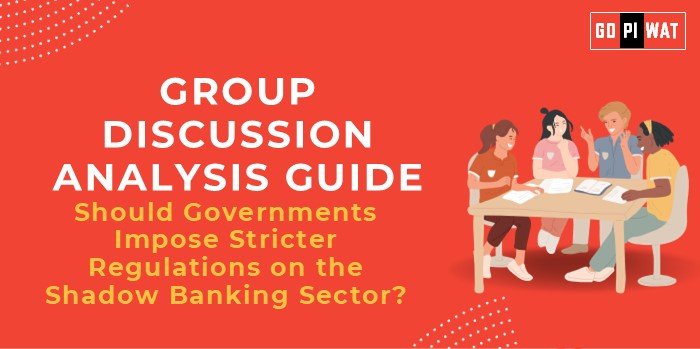📋 Group Discussion (GD) Analysis Guide: Should Governments Impose Stricter Regulations on the Shadow Banking Sector?
🌐 Introduction to the Topic
Context: The shadow banking sector, often comprising non-bank financial intermediaries, operates outside traditional banking regulations. While it boosts financial inclusion and economic growth, its unregulated nature poses systemic risks, especially during financial crises.
Background: Following the 2008 Global Financial Crisis, shadow banking’s role in exacerbating systemic risk became evident. Nations like the U.S. and China have implemented varying levels of regulation to mitigate these risks.
📊 Quick Facts and Key Statistics
- 🌍 Size of Shadow Banking: Globally valued at $64 trillion (2023), representing 40% of the traditional banking sector.
- 🇮🇳 India’s NBFCs (Non-Banking Financial Companies): Contribute 12% to the GDP, with assets worth ₹51 lakh crore.
- 🇨🇳 China’s Shadow Banking Contraction: Reduced by 20% over the last decade through regulatory crackdowns.
- 📈 Global Financial Stability Report (IMF, 2023): Shadow banks are responsible for 75% of global credit intermediation.
🧑🤝🧑 Stakeholders and Their Roles
- 🏛️ Governments: Enact policies to ensure stability while fostering growth.
- 🏦 Central Banks: Monitor systemic risks and implement monetary interventions.
- 🏢 Shadow Banks: Provide credit access, especially to underserved sectors.
- 👥 Consumers and Businesses: Benefit from enhanced credit availability but are exposed to potential risks.
🏆 Achievements and Challenges
🎯 Achievements:
- Credit Accessibility: Shadow banks fill gaps left by traditional banks, especially in MSMEs and rural sectors.
- Innovation: Pioneering in fintech solutions, enabling faster and easier credit processing.
- Economic Contributions: Significant role in GDP growth in emerging economies like India and Brazil.
⚠️ Challenges:
- Systemic Risks: Amplification during crises, e.g., Lehman Brothers’ collapse.
- Regulatory Arbitrage: Exploitation of regulatory loopholes.
- Consumer Protection Issues: Lack of oversight leads to potential exploitation and fraud.
Global Comparisons:
• U.S.: Post-crisis regulations include tighter disclosure norms under the Dodd-Frank Act.
• China: Reduced sector size via restrictions on wealth management products.
Case Study: India’s IL&FS default in 2018 showcased the ripple effect shadow banking can create within the broader financial ecosystem.
📋 Structured Arguments for Discussion
- Supporting Stance: “Stricter regulations will enhance systemic stability and prevent financial crises, as evidenced by China’s regulatory measures curbing shadow banking excesses.”
- Opposing Stance: “Overregulation may stifle innovation and limit credit access, particularly in developing economies reliant on shadow banking for growth.”
- Balanced Perspective: “While stricter oversight is necessary to mitigate risks, a nuanced approach balancing regulation and innovation is critical to sustaining economic growth.”
💬 Effective Discussion Approaches
- 💡 Opening Approaches:
- Highlight statistics on shadow banking’s contribution to systemic risks globally.
- Use case studies like IL&FS or Lehman Brothers to set context.
- 💡 Counter-Argument Handling:
- Emphasize data showing how balanced regulations have benefited economies.
- Point to alternatives like targeted oversight rather than blanket bans.
📈 Strategic Analysis of Strengths and Weaknesses
Strengths:
- Increased financial inclusion.
- Innovation.
Weaknesses:
- Regulatory arbitrage.
- Lack of transparency.
Opportunities:
- Enhance oversight through technology (RegTech).
Threats:
- Global spillovers during crises.
📚 Connecting with B-School Applications
- Real-World Applications: Studying shadow banking’s role in project finance, microcredit, and fintech.
- Sample Questions:
- 🧐 “How should governments balance regulation and innovation in financial markets?”
- 📘 “What lessons can India learn from China’s shadow banking regulations?”
- Insights for Students: Explore fintech innovations, their implications, and regulatory responses in your internships and projects.


